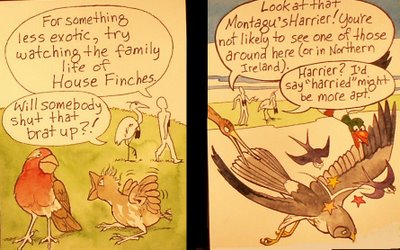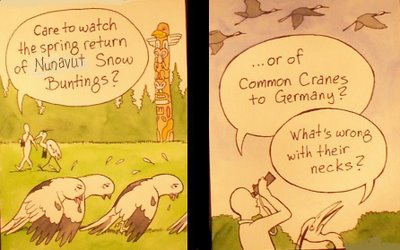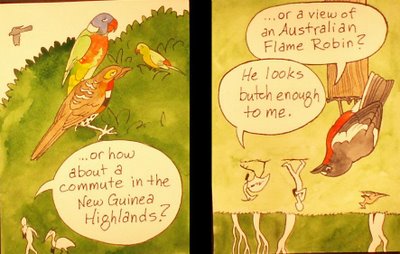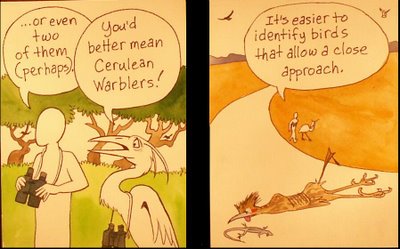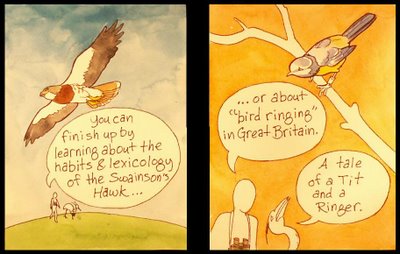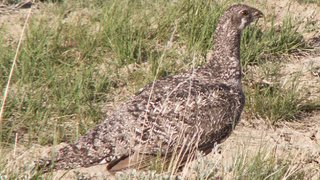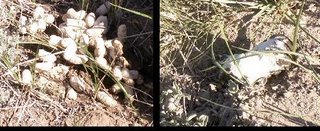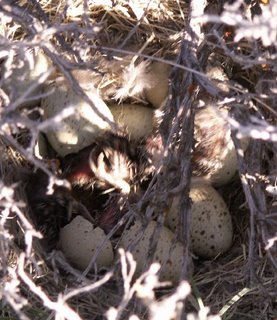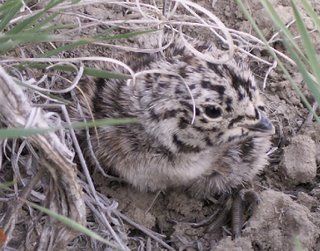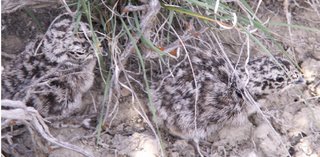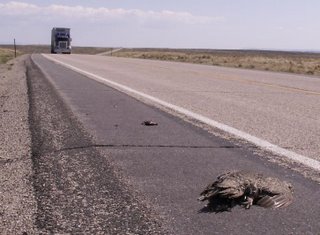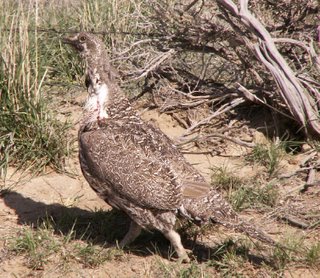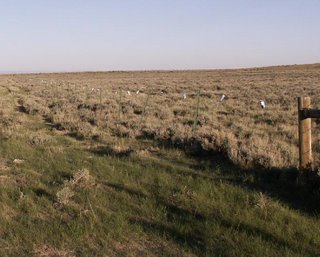A PINEDALE ANTICLINE PHOTOJOURNAL--Part II: The Raptors
 Last year's exceptional rains nurtured a spectacularly successful generation of wildlife that has come back to roost (and nest) this year. It's hard to believe the current density of raptor nests on the Pinedale Anticline. Golden Eagles (Aquila chrysaetos) are the top predator of the area, but are plentiful nonetheless. I found just a single cliff nest during my recent one day and two half days, but saw so many adult birds that I'm certain they are nesting at close to maximum density. I didn't want to get close enough to disturb the eyrie, but through a spotting scope I could see an adult bird either incubating or brooding very small young, meaning the birds won't fledge until mid-July at the earliest. One of these years I'd like to survey nest contents of Golden Eagles on the Anticline. I know the birds prey heavily on Sage Grouse (Centrocercus urophasianus), and surely on White-tailed Jackrabbits (Lepus townsendii), too, but I'd be interested to see how closely reality matches my expectations (it usually tends to surprise me).
Last year's exceptional rains nurtured a spectacularly successful generation of wildlife that has come back to roost (and nest) this year. It's hard to believe the current density of raptor nests on the Pinedale Anticline. Golden Eagles (Aquila chrysaetos) are the top predator of the area, but are plentiful nonetheless. I found just a single cliff nest during my recent one day and two half days, but saw so many adult birds that I'm certain they are nesting at close to maximum density. I didn't want to get close enough to disturb the eyrie, but through a spotting scope I could see an adult bird either incubating or brooding very small young, meaning the birds won't fledge until mid-July at the earliest. One of these years I'd like to survey nest contents of Golden Eagles on the Anticline. I know the birds prey heavily on Sage Grouse (Centrocercus urophasianus), and surely on White-tailed Jackrabbits (Lepus townsendii), too, but I'd be interested to see how closely reality matches my expectations (it usually tends to surprise me). The other American Eagle, the Bald Eagle (Haliaetus leucocephalus), has become far more common in our area since the banning of DDT in the 1970s. This photo shows one of two Bald Eagle nests we found in Narrowleaf Cottonwoods (Populus angustifolia) along the Green River. Both nests appeared to harbor young bird(s), a few days old. Twenty-five years ago, nesting Bald Eagles here were unknown.
The other American Eagle, the Bald Eagle (Haliaetus leucocephalus), has become far more common in our area since the banning of DDT in the 1970s. This photo shows one of two Bald Eagle nests we found in Narrowleaf Cottonwoods (Populus angustifolia) along the Green River. Both nests appeared to harbor young bird(s), a few days old. Twenty-five years ago, nesting Bald Eagles here were unknown. One of my favorite predatory birds is the Ferruginous Hawk (Buteo regalis). This bird is the largest and most powerful North American member of the genus Buteo, and in many ways is more like a small eagle. These spectacular birds are said to prey almost exclusively on mammals, but a friend of mine had a tiercel Peregrine killed by a wild Ferruginous last year. The nests that I've seen have contained mostly remains of groundsquirrels (Spermophilus spp.).
One of my favorite predatory birds is the Ferruginous Hawk (Buteo regalis). This bird is the largest and most powerful North American member of the genus Buteo, and in many ways is more like a small eagle. These spectacular birds are said to prey almost exclusively on mammals, but a friend of mine had a tiercel Peregrine killed by a wild Ferruginous last year. The nests that I've seen have contained mostly remains of groundsquirrels (Spermophilus spp.). Ferrugies nest both in trees and on cliffs and bluffs. Most cliff nests are situated like the one in the photo (the incubating hen's head is just visible), on the top of a pinnacle--often at the very top of the cliff. Many of these nests can be walked right up to. I've even seen some that were built atop a simple knoll, with no cliff involved. A pair near Farson built a nest this year on top of a haystack. Incubating Ferruginous Hawks are very easily stressed, and their nests should never be approached before the eggs have hatched.
Ferrugies nest both in trees and on cliffs and bluffs. Most cliff nests are situated like the one in the photo (the incubating hen's head is just visible), on the top of a pinnacle--often at the very top of the cliff. Many of these nests can be walked right up to. I've even seen some that were built atop a simple knoll, with no cliff involved. A pair near Farson built a nest this year on top of a haystack. Incubating Ferruginous Hawks are very easily stressed, and their nests should never be approached before the eggs have hatched. In the Utah deserts, Ferruginous eggs usually hatch around the beginning of May. Up on the Anticline, it's usually a month later. The hen does most of the incubating, and the tiercel provisions her. He'll spend most of his time sitting at the top of a cliff, within sight of the nest. This year, Ferrugies are nesting in close to maximum density. I found five cliff nests, one big tree nest with a very dark hen incubating, and that haystack nest. In a week or so, I'll probably go back up to watch some eyries from a blind, just because I love these birds so.
In the Utah deserts, Ferruginous eggs usually hatch around the beginning of May. Up on the Anticline, it's usually a month later. The hen does most of the incubating, and the tiercel provisions her. He'll spend most of his time sitting at the top of a cliff, within sight of the nest. This year, Ferrugies are nesting in close to maximum density. I found five cliff nests, one big tree nest with a very dark hen incubating, and that haystack nest. In a week or so, I'll probably go back up to watch some eyries from a blind, just because I love these birds so. Swainson's Hawk (B. swainsoni), a relative of the Ferruginous, is another (I believe) beneficiary of the DDT ban. Today they are abundant in the Intermountain West, but in the '70s they were quite rare. I expect their largely insectivorous ways made them susceptible to DDT when that chemical was used widely in American agriculture, though I know of no studies to back this up. These slim, long-winged birds are perhaps the most variable American buteo. The typical adult has a white throat and belly, separated by a dark breast band. The pale wing linings contrast strongly with dark flight feathers. A bird that looks like this is easy to identify, but many individuals deviate wildly from the standard pattern. Some birds even lack the dark flight feathers, and, to confuse the issue further, some sport quite red tails. This incubating hen is uniformly dark. The best diagnosis for the bird is its distinctive slender build, erect posture and its long, thin wings. The photo shows one of two Swainson's Hawk nests I saw. The other pair had not yet layed eggs. Microecos has a very good recent post on this interesting bird.
Swainson's Hawk (B. swainsoni), a relative of the Ferruginous, is another (I believe) beneficiary of the DDT ban. Today they are abundant in the Intermountain West, but in the '70s they were quite rare. I expect their largely insectivorous ways made them susceptible to DDT when that chemical was used widely in American agriculture, though I know of no studies to back this up. These slim, long-winged birds are perhaps the most variable American buteo. The typical adult has a white throat and belly, separated by a dark breast band. The pale wing linings contrast strongly with dark flight feathers. A bird that looks like this is easy to identify, but many individuals deviate wildly from the standard pattern. Some birds even lack the dark flight feathers, and, to confuse the issue further, some sport quite red tails. This incubating hen is uniformly dark. The best diagnosis for the bird is its distinctive slender build, erect posture and its long, thin wings. The photo shows one of two Swainson's Hawk nests I saw. The other pair had not yet layed eggs. Microecos has a very good recent post on this interesting bird. The best-known American buteo is the Red-tailed Hawk (B. jamaicensis), and it's as healthy on the Anticline as anywhere else. I found six nests of this generalist on my last trip to the Anticline: three in trees, three on cliffs. All of them appeared to have very small young.
The best-known American buteo is the Red-tailed Hawk (B. jamaicensis), and it's as healthy on the Anticline as anywhere else. I found six nests of this generalist on my last trip to the Anticline: three in trees, three on cliffs. All of them appeared to have very small young.
A particularly goofy-looking hen.

Great Horned Owls (Bubo virginianus) are the only owl species I've seen on the Anticline. Here the hen roosts next to her three young birds in an abandoned Golden Eagle nest. I'm surprised to have never seen a Short-eared Owl (Asio flammeus) or even a Long-eared (A. otus). There is plenty of what passes in my eyes as good breeding habitat for the former species and good winter habitat for the latter, but I've never seen or heard either up here. I'm also a little surprised to have never seen or heard a Poor-will (Phalaenoptilus nuttalli) up here, either. It's probably just a bit too cold for any of these birds. I imagine that Screech Owls probably haunt the riparian areas, but I've yet to confirm that.
 Last of all is the Prairie Falcon (Falco mexicanus), a bird that is, to me, nearly as iconic of the region as the Sage Grouse. We found six Prairie Falcon eyries (in this photo, the tiercel scolds us, while the falcon incubates). These birds are close to the size and build of a Peregrine (F. peregrinus), but are not as wedded to birds as are their more widespread cousins. Prairies will take a wide range of prey. The other day I watched a tiercel snatch a chipmunk (Tamias sp.) from the valley floor, and haul it off to his waiting mate, harried the whole while by a much larger Swainson's Hawk. The Utah desert Prairie Falcons are fledging now; in the mountains they're all hatched (the early mountain eyrie I posted about earlier this year fledged two weeks ago), but Prairies on the Anticline are all still on eggs.
Last of all is the Prairie Falcon (Falco mexicanus), a bird that is, to me, nearly as iconic of the region as the Sage Grouse. We found six Prairie Falcon eyries (in this photo, the tiercel scolds us, while the falcon incubates). These birds are close to the size and build of a Peregrine (F. peregrinus), but are not as wedded to birds as are their more widespread cousins. Prairies will take a wide range of prey. The other day I watched a tiercel snatch a chipmunk (Tamias sp.) from the valley floor, and haul it off to his waiting mate, harried the whole while by a much larger Swainson's Hawk. The Utah desert Prairie Falcons are fledging now; in the mountains they're all hatched (the early mountain eyrie I posted about earlier this year fledged two weeks ago), but Prairies on the Anticline are all still on eggs.It's nice to be able to report such positive ecological health from this area. The density of raptor nests was staggering. Many nests were just a hundred yards or so apart. The Swainson's Hawk nest pictured above was in direct view of nesting Prairie Falcons and Ferruginous Hawks. Kestrels (Falco sparverius), and Marsh Hawks, or Northern Harriers (Circus cyaneus) were fairly abundant, and I saw an Osprey (Pandion haliaetus) and a possible Merlin (Falco columbarius). I'll wrap this little series up in part iii, which will cover all the stuff that isn't a raptor or grouse...well, okay...some of it.
_____________________
All photographs in this post were taken by CPBvK on the Pinedale Anticline, May 15-17, 2006











